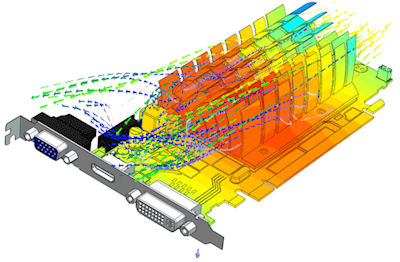September 26, 2013
By Anthony J. Lockwood
Dear Desktop Engineering Reader:
 |
Our world of electronics embedded in everything is truly a wonder. It’s a wonder that it all doesn’t burst into flame. Think of it. You have mechanical design engineers handling the physical aspects of how some PCB (printed circuit board) fits into a box with its component neighbors. And you have electrical engineers doing the electronics. And both are expected to deal with thermal design issues within their own zone of influence even though they’re not CFD (computational fluid dynamics) gurus. Not that there aren’t CFD experts around. Rather, the movement, some might say religion, of upfront analysis has pushed a whole mess of CFD work down onto the CAD and EDA mavens.
So then, what’s the deal with that upfront general-purpose CFD application your design and electronic engineers use? Is it really a helpful tool? How’s its interoperability across all your CAD, EDA, industrial design, and CAE toolsets? Does it handle geometry and post-processing gracefully? Does it really make accurate electronics thermal design a fluid partner in your concept through manufacturing workflows? Does it make significantly more work for the design and electronics people and significantly less for CFD aces? Can your CAD, EDA, and CFD people make good use of it?
These are just a few of the questions that came to mind as I was reading today’s Check It Out offering, “A Step Change in Electronics Thermal Design: Incorporating EDA and MDA Design Flows.”
The gist of this 13-page PDF, written by Mr. Anonymous for Mentor Graphics, is that thermal simulation of electronics equipment is a bear and that general-purpose CFD tools are not optimized for the job. FloTHERM XT from Mentor Graphics, however, is optimized for thermal electronics simulations and engineered for use by CAD, EDA, and CFD users. Don’t worry. This is an engineer’s soft, semi-technical sell.
So, what are the optimization challenges? Well, first and obvious, electronics equipment is crammed with stuff—cables, PCBs, fans, heatsinks, and all those chips and traces. You have tight airflows, convection issues, and conduction headaches to model right within a tight timeframe. And you have scale disparities ranging from microns to meters, variables galore, and the ever popular mesh generation. Since power densities within a package, PCB, and so on are increasing—thus reducing the proportion of the temperature rise that occurs in air— the biggest challenge, it seems, is the need to model conduction within a solid structure. This is why MCAD and EDA integration are so important for accurate results since one affects the other. Think heatsink design, for one.
The paper then offers a look into how the company’s FloTHERM XT electronics-cooling software works. It explains where FloTHERM XT fits into the process—from concept through sign-off—and maps what it could do for you confronting the challenges of thermal simulation of electronic equipment.
FloTHERM XT is not general-purpose CFD. It’s described as semi-automatic, which can help both the non-CFD user and the CFD expert obtain accurate results. Take meshing, for example. FloTHERM XT’s semi-automatic meshing means that it handles most mesh-related operations, but you can adjust things manually whenever you want. That means both amateur and pro CFD users should be able to quickly build a good mesh and get on with validating or dispensing with design alternatives.
The paper ends with an interesting case study that brings home all the main points advanced through its earlier discussions. There are also a number of good illustrations to enhance the discussions as well as a list of references for the more technically inclined to explore.
FloTHERM XT sounds like an interesting tool, and, like everything else I’ve read from this company, this paper is very well done. Hit the Check It Out link and download “A Step Change in Electronics Thermal Design: Incorporating EDA and MDA Design Flows” to see for yourself.
Thanks, Pal. – Lockwood
Anthony J. Lockwood
Editor at Large, Desktop Engineering
A Step Change in Electronics Thermal Design: Incorporating EDA and MDA Design Flows
Subscribe to our FREE magazine, FREE email newsletters or both!
About the Author
Anthony J. Lockwood is Digital Engineering’s founding editor. He is now retired. Contact him via [email protected].
Follow DE





